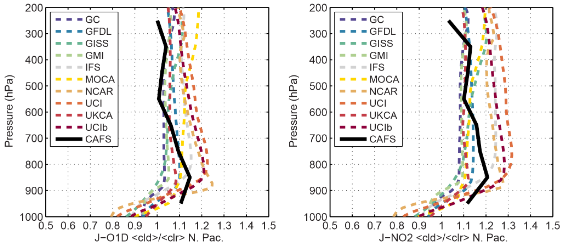ARIM Science Highlight
Representing clouds in global models is extremely challenging. Clouds vary in phase (ice and water), form at different altitudes, overlap, and their features are often small compared to model pixels (50-200 km). Clouds can shade or reflect radiation depending on the relative location of the sun. This is important as the energy of sunlight drives atmospheric chemical reactions. Airborne measurements of actinic flux during the NASA Atmospheric Tomography mission (ATom) provided a measure of the influence of clouds over remote oceanic regions. Hall et al. (2019) built a statistical tool to evaluate the effect of clouds on photolysis rates over the remote Pacific and Atlantic Oceans as represented in nine global models. The study found an inconsistency among the models but they did fall into two basic groups. The first group was dominated by nearly clear-sky conditions, due in part to the treatment of cloud fractions when averaging over large model grid cells. The second group was more influenced by clouds and generally similar to the measurements with enhanced photolysis rates aloft and diminished at the surface.

Figure 1. Profiles of the ratio of photolysis frequencies of ozone (left) and NO2 (right) under clear/cloudy conditions over the remote north Pacific ocean. The CAFS data was is shown as a ratio to the NSF NCAR TUV radiative transfer model under clear-sky conditions. The models compared simulations with and without clouds.